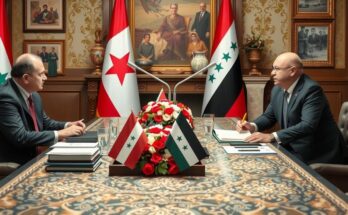The conflict in Sudan is characterized by armed confrontations in Khartoum between the military and the Rapid Support Forces (RSF), led by General Hemedti. Originating from the marginalized regions of Darfur, Hemedti’s rise signifies a wider struggle against historical grievances of exclusion, as he navigates between local aspirations and the existing military elite. His recent control over key economic resources bolsters his power, raising critical questions about sustainability and future governance in Sudan amidst growing tensions.
The ongoing conflict in Sudan is being driven by intense clashes in the capital city of Khartoum, primarily fueled by rising tensions between the military and the Rapid Support Forces (RSF), a powerful paramilitary group. This discord centers around the integration of the RSF into the national armed forces, which remains a critical, yet unsigned condition of a transition agreement that both factions have manipulated since 2021. The leadership of the RSF, under General Mohamed Hamdan Dagolo, widely known as Hemedti, plays a significant role in this escalating civil unrest, marking Hemedti as a prominent figure amidst Sudan’s tumultuous political landscape. Derived from the Darfurian Arab militia known as the Janjaweed, the RSF has developed into a formidable force within a decade, having transitioned from its roots in marginalization to dominating the political arena in Khartoum. Hemedti’s rise encapsulates a narrative of political entrepreneurship defined by violence and exploitation. His ascent to power illustrates the perils that stem from the Sudanese state’s historical marginalization of peripheral regions. Being an outsider with minimal formal education, Hemedti emerged from the disadvantaged communities of Sudan. He initially gained recognition as a commander within the Janjaweed militia during the Darfur conflict, later leveraging his military success into considerable political influence after negotiating roles with successive regimes, including a lucrative arrangement with the former President Omar al-Bashir. Hemedti’s RSF was officially formed in 2013 and quickly became vital to Sudan’s military interventions, notably in Yemen, hence accruing significant financial resources. Recent acquisitions, including control over the artisanal gold mines in Darfur, assert his growing economic power, allowing him access to the nation’s primary export revenues. Hemedti’s parallel to state mercenarism mirrors historical practices seen in other parts of Africa, utilizing paramilitary forces to maintain a balance of power within conflict zones. Nevertheless, the emergence of the RSF and Hemedti signifies a departure from the long-held tradition of leadership emanating from Sudan’s central Nile valley. His ascent has rekindled fears of a return to tyranny, remembered by past generations. The unintended consequences of empowering groups like the Janjaweed reveal how the state’s strategy to manipulate local conflicts has ultimately undermined its authority, rendering a once-displaced force now capable of challenging the existing regime. Hemedti serves as a double-edged sword—once a creature of the state, he now threatens to redefine Sudan’s power structures as a symbol of both marginalization and aspiration for those he represents. This situation exemplifies the complex interplay of socio-political dynamics in Sudan, shaping a crisis that reflects deeper historical grievances. While Hemedti may have emerged as a champion for the historically marginalized groups, his leadership raises critical questions about the future direction of the country amidst turmoil and chaos.
The conflict in Sudan stems from long-standing tensions between the military establishment and the RSF, intricately tied to historical marginalization and socio-political dynamics. The RSF’s emergence from the Janjaweed militia, initially established one of Sudan’s key strategies during the Darfur crisis, highlights the complexities of power shifts within the country. The ongoing disputes regarding military integration reflect larger issues within Sudan’s governmental structure and societal grievances that date back decades. Understanding the significance of Hemedti’s rise is essential for comprehending the potential consequences for Sudan’s sociopolitical landscape, as it encapsulates the historical narrative of conflict between established power dynamics and marginalized populations.
In summary, the conflict in Sudan is rooted in the complex intersection of military power and paramilitary influence, significantly represented by General Hemedti and the RSF. This evolution reflects the country’s embedded historical conflicts and the struggle for representation across different regions. As dynamics shift, Sudan faces uncertainty about its political future, indicative of the broader implications of marginalization and the rise of violent political entrepreneurship. The situation poses a profound challenge to achieving stability and governance in a nation marked by decades of conflict and strife.
Original Source: www.thedailystar.net



